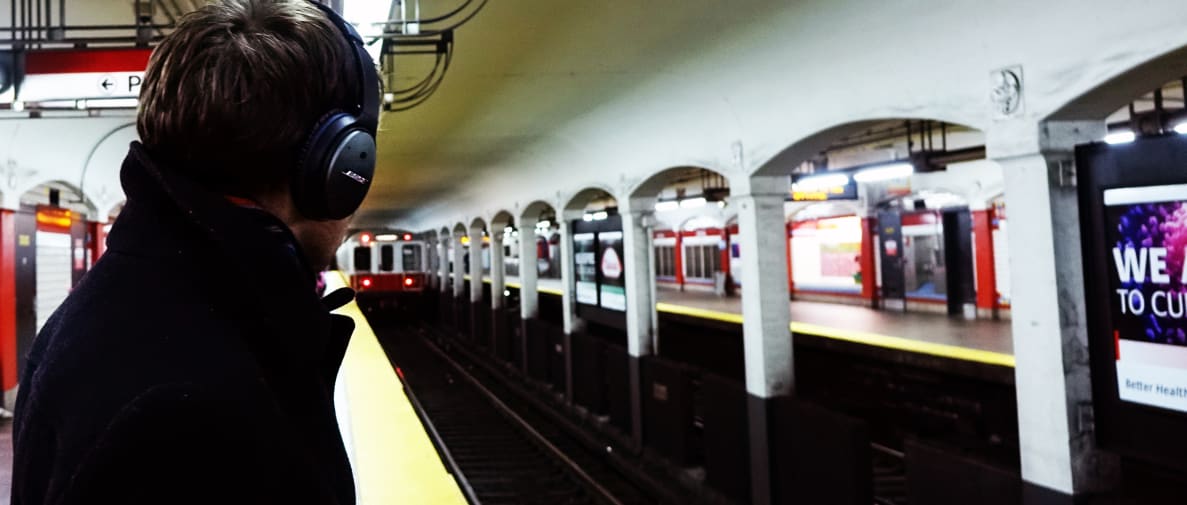The Bose QuietComfort 25 over-ears (MSRP $299.95) are the successors to those popular cans, delivering the latest in acoustic noise-canceling and active equalization. They're sturdy, comfortable, and sound great while they quiet the world around you. Unfortunately, they're a ghost of their former selves when the battery runs out.
If you're not ready to spend three Benjamins for a quieter commute, Panasonic's HC800 noise cancelers may be a better choice. They lack the style and comfort of the QC25s, but you can find them for about $180 online. If you choose to spring for the QuietComfort 25s, rest assured that they're one of the best choices this year in active noise canceling.
The Outfit
Solid craftsmanship backs up hours of comfort
At a $300 list price, we expect not only solid audio and useful canceling from the QC 25 over-ears, but good design and materials, too. Fortunately, these cans live up to their steep price tag by delivering comfortable long-term listening and high-quality materials. Fans of the older QC15s will feel right at home here, as this design is quite similar.
Whether you opt for the black or white QC25s (we got the black ones), you'll enjoy well-padded ear cups, a flexible band that cushions your head with a soft mesh material, and sturdy metallic backing emblazoned with the Bose insignia. Good cup movement and generous arm extensions ensure that the QC 25 over-ears fit most heads comfortably. The cups in particular hug the outside of the ears brilliantly; you might feel as though you were born with them on your head.
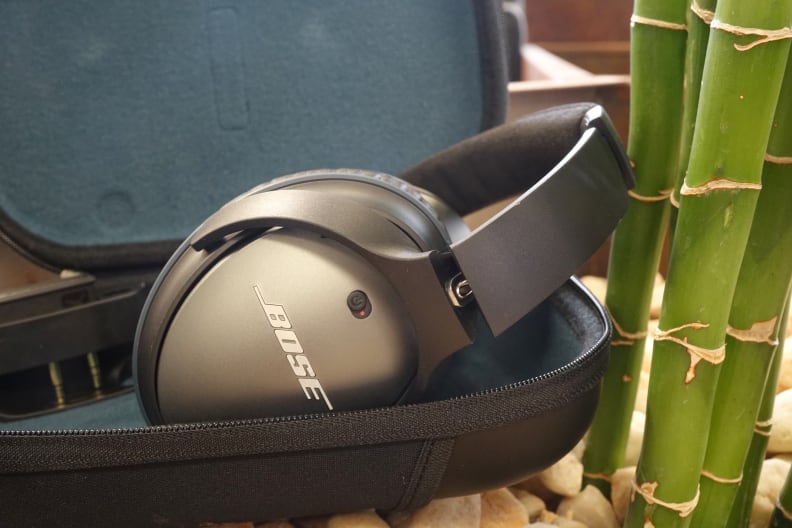
The Bose QC 25 are very comfortable, featuring high-quality materials and cushy ear pads. As is traditional, the switch for active noise canceling is on the back of the right ear cup.
The included cable is neither terribly sturdy nor particularly handsome—especially because it's detachable, it sort of feels like Bose just borrowed it from another product. That's not to say it's a cheap cable, but it compares poorly to the craftsmanship of the headphones themselves. The 2.5mm–3.5mm male-to-male design also makes it likely that you won't have a replacement hanging about should you lose or break this one.
Bose includes a handsome zip-up case and airplane adapter with these cans, as well as the single AAA battery you'll need to power the acoustic noise canceling. Following the industry trend, you'll find the small power switch for the noise canceling feature on the back of the right ear cup.
There's also a controller and microphone on the cable that allows users to adjust the volume, pause/play music, skip tracks, alternate playlists, and answer phone calls. According to Bose, these features will work not only with iOS products, but with "most Android, Windows, and Blackberry" phones as well.
{{ photo_gallery "design" }}
The Audio
Decent audio quality, great canceling
Acoustic noise canceling is what truly sets the QC2s apart from the over-ear crowd, but they still need to deliver a premium audio experience to justify their price.
In this case, one function begets the other: While canceling is active, the QC 25s present a healthy soundscape with subtle low-end support and plenty of volume and clarity throughout the middle and treble ranges. If you turn noise canceling off or simply run out of juice, however, the "inactive" sound lacks much of the valuable details it previously presented.
What do this mean more practically? You're going to want an extra AAA battery or two before you take any long trips. Running out of power midway will be like downgrading to a much cheaper set of headphones. Previously ample sub-bass support is all but lost without the ANC, while midrange elements—the meat-and-potatoes of guitars and vocals—grow much quieter (and less detailed) by comparison.
Musical harmonic distortion, like clipped high notes or missing bass tones, is a no-show here. While canceling is on, there's practically no distortion, even in the almost-always-distorted sub-bass range. This is an awesome result, especially for active cancelers, and means your music is clean and crisp from the highest trills to the deepest thumps.
Last but certainly not least, the QC 25s do a great job quieting noise. Sub-bass and bass noises, like rumbling airplane engines or honking truck horns, are diminished by as much as 30 dB—which makes a huge difference. Higher-pitched noises like crying babies and ringing phones are dampened too, between 30 and 40 dB. This means commuters and travelers can safely listen at low volumes without interruptions from the world around them.
The best way to use the QC 25 over-ears is pretty clear-cut: Turn ANC on and leave it on. Key performance elements like audio quality and harmonic distortion are at their best that way, so pack a few extra AAAs when you travel.
The Verdict
Not the best cans around, but the QC25s are another knock-out set of ANCs from Bose
The QC25s are arguably the flagship personal audio product from Bose, destined to show up at every airport you visit for the next five to ten years. But like the QC15s before them, the QC25s are battery-dependent. They'll now play music without ANC on, but the soundscape is so much better with the function enabled that you'll never want to turn it off. Solving this dilemma is simple enough—just spend $5 on a four-pack of AAAs—but it's the only way to get your money's worth here.
The sound quality otherwise is not the best that we've seen. The best headphones we've tested in recent memory—the Beyerdynamic Custom One Pros— are still available for much less money. If you're set on a pair of active noise canceling phones there are also Panasonic's unheralded RP-HC800 over-ears to consider, which offer slightly better overall sound quality for less money at the expense of comfort and style.
That said, we can forgive a few flaws in the sound production considering how terrific the QC25's canceling is. Every annoying sound is quieted—from droning, honking truck horns, to whining airplane rotors, to those children who keep singing Ariana Grande. So long as you're listening to your music at a decent volume, audible nuisances in your vicinity shouldn't be bothersome. Combine that with a supremely comfortable design and you have the perfect travel companion for your next long-distance flight.
The Insides That Count
The Bose QuietComfort 25 over-ears (MSRP $299.95) deliver a consumer-friendly sound, great isolation, and low amounts of distortion—as long as active canceling is on. Without it, the sound stage suffers dramatically, and sub-bass/bass elements gain notably more harmonic distortion. The solution? About $4.79 for a four-pack of AAA copper tops.
Isolation
If there's one place the QC 25 over-ears shine without question, it's in the isolation department. Our isolation test measures a set of headphones' ability to isolate noise both with and without an active noise canceling feature triggered, measuring their natural isolation ability as well as the improvements made by triggering the active noise canceling.
With ANC on, the QC 25 over-ears reduce sub-bass/bass tones around 20 dB, meaning they're reduced by 25% of their original volume. While midtones aren't affected as prominently (only around 15-20 dB), high-mid and high-end frequencies are dampened by 25-35 dB, sounding out at only one-eighth of their original volume.
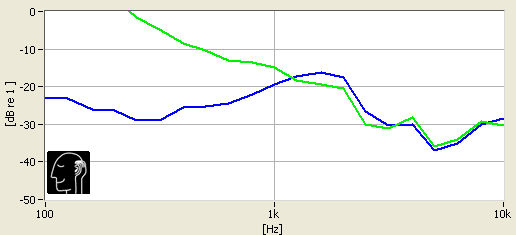
The Bose QC25s do as good a job quieting outside noise as any other noise cancelers we've tested this year. The meat of bass frequencies are squashed by about 30 dB, for example.
Frequency Response
Like most ANC-equipped cans, these Bose offer up a different soundscape depending upon whether or not their canceling feature is active. We measure the frequency response with ANC turned on and off, and found major differences in bass and midtone emphasis, as well as fairly notable differences between the left and right speaker channels.
With ANC enabled, the QC 25 over-ears give plenty of emphasis to sub-bass and bass tones, mustering a flat, even response that's sure to please audiophiles. This emphasis tapers very gently from ~80 dB to ~75 dB at the 1kHz midrange point, dropping off notably for high-mid trebles and spiking again (slightly) around 6kHz. The result is a consumer-facing sound that's nevertheless subtle and well-balanced—save for a period of under-emphasis right around 3kHz.
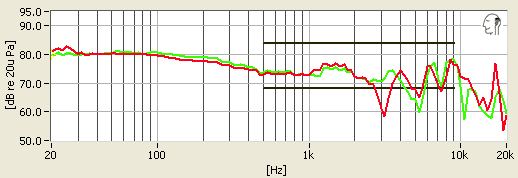
The QC25 over-ears sound best when ANC is active, but they still exhibit a serious lack of emhpasis around 3kHz.
With ANC turned off, the soundscape is thrown off-balance. It's the sub-bass range between 20 and 60 Hz that takes the biggest hit, dropping from a healthy 80 dB playback to ~75 in the left channel and closer to 70 in the right channel. This volume discrepancy between channels doesn't stop there, actually: Across the entire frequency spectrum, the left/right channels are out of sync in terms of volume. There's also a notable lack of emphasis between 1.8kHz and 6kHz, which means a lot of details lost.
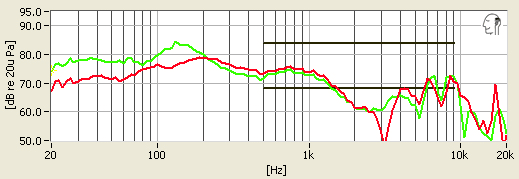
With ANC off, the Bose QC 25 sound quite a bit worse compared to when ANC is active.
Total Harmonic Distortion
Distortion, the natural presence of mechanical sounds and/or clipped harmonics or bass tones during speaker playback, can be the bane of an otherwise stellar set of cans. Akin to their frequency response test, the Bose QC 25 over-ears perform much better with ANC turned on than when it's off, again compelling consumers to simply never run out of juice.
With ANC enabled, distortion is kept very low: Even the sub-bass range, the most distorted frequency range, never rises above ~10% THD. This number quickly drops to below 3% distortion—the ideal amount—between 60 and 10kHz.

There's a much higher degree of THD present when ANC is turned off, compared to when it's on.
With ANC turned off, things change quite a bit. THD within the sub-bass range (audibly, ~20 Hz–60Hz) jump between 25% and 40% THD depending on the channel analyzed, which is much higher than anything reported while ANC was on. The right channel, in particular, peaks just above 3% THD into the bass range above 60Hz, which is a notably worse result compared to when ANC is on.

From top to bottom, the QC 25's exhibit less than 4% THD, which is a terrific result.
Other Tests
{{ photo_gallery name="New Gallery" }}
Meet the testers
Michael Desjardin graduated from Emerson College after having studied media production and screenwriting. He specializes in tech for Reviewed, but also loves film criticism, weird ambient music, cooking, and food in general.
Lee was Reviewed's point person for most television and home theater products from 2012 until early 2022. Lee received Level II certification in TV calibration from the Imaging Science Foundation in 2013. As Editor of the Home Theater vertical, Lee oversaw reviews of TVs, monitors, soundbars, and Bluetooth speakers. He also reviewed headphones, and has a background in music performance.
Checking our work.
Our team is here to help you buy the best stuff and love what you own. Our writers, editors, and experts obsess over the products we cover to make sure you're confident and satisfied. Have a different opinion about something we recommend? Email us and we'll compare notes.
Shoot us an email
